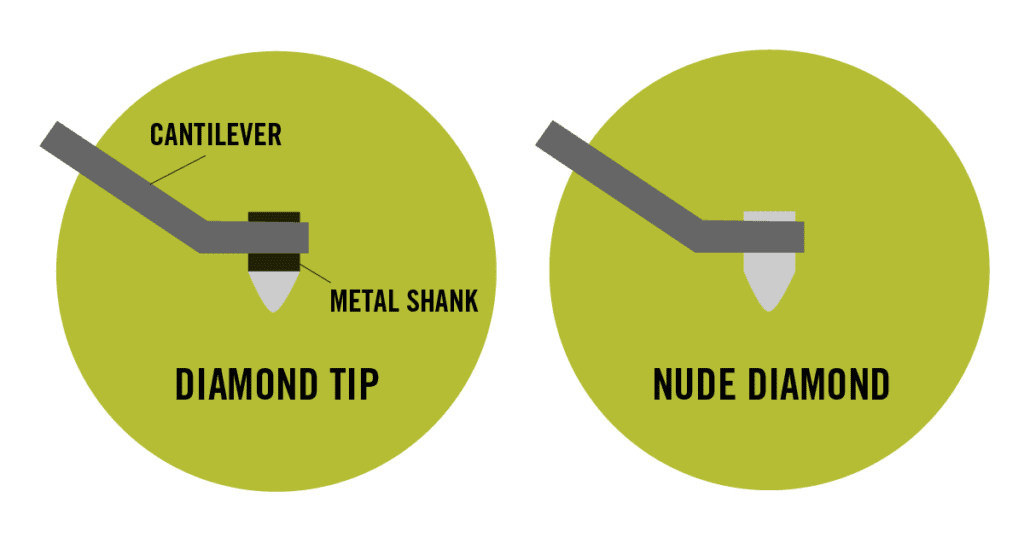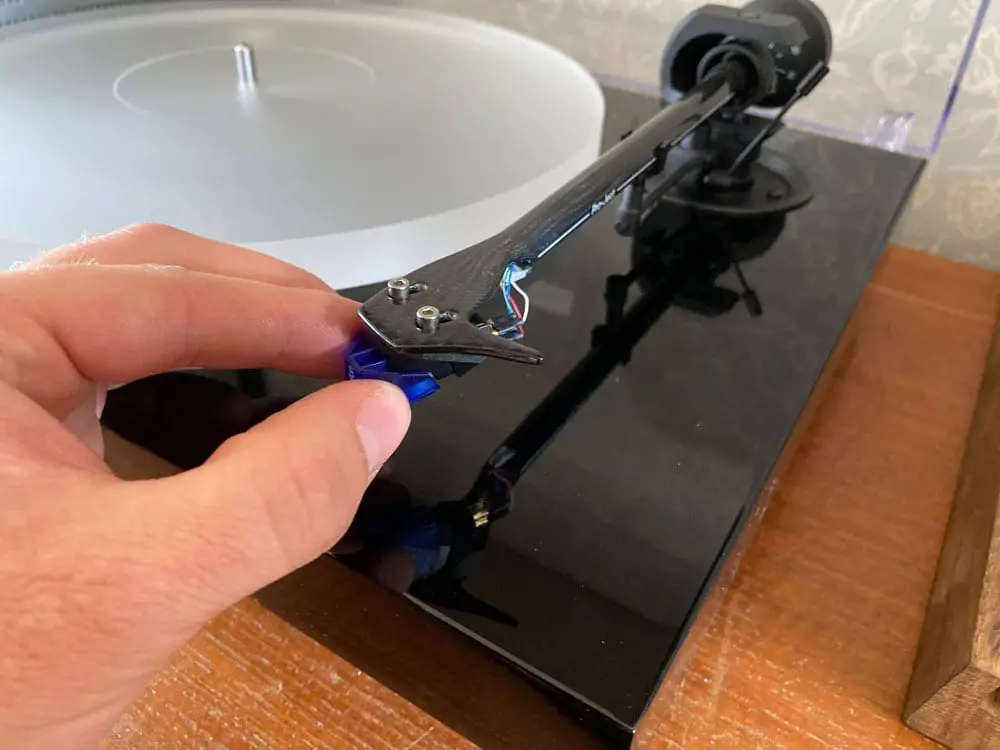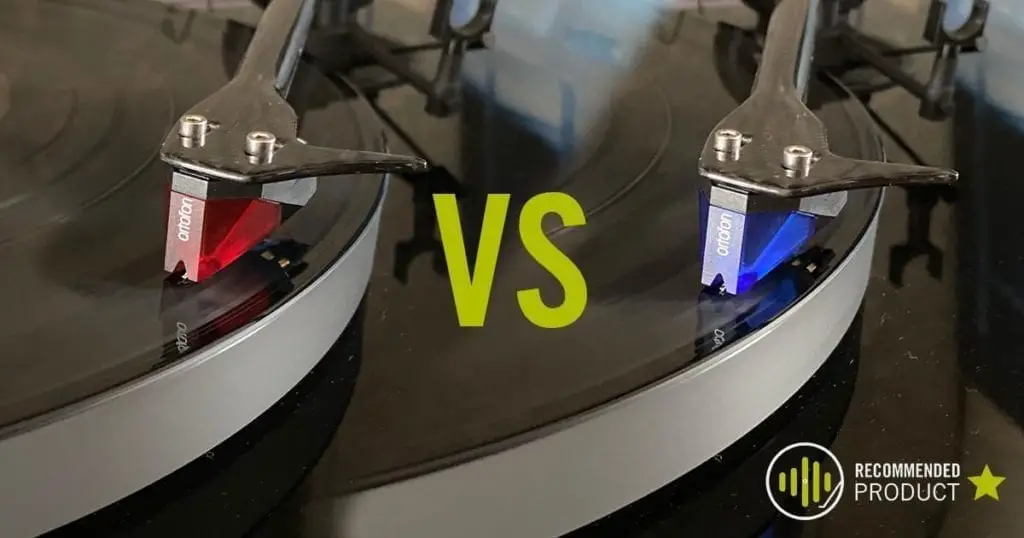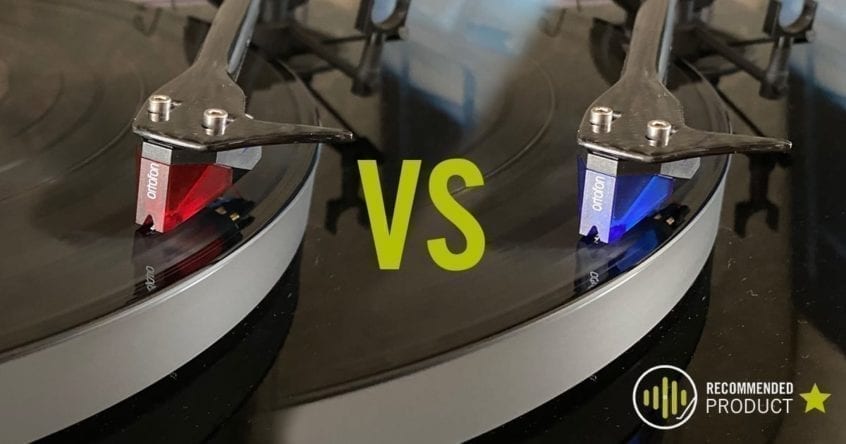The 2M series from Ortofon has, for many, become the de facto cartridge and styli range for the vinyl revival. The ubiquitous 2M Red, in particular, has rightly earnt a reputation as one of the best-sounding affordable cartridges on the market at just $99 or £95. Sound-wise, the performance is undoubtedly impressive across the 2M range, which is semi-modular to make upgrading effortless as and when budget allows.
For example, the 2M Red and Blue styli are interchangeable, as are the 2M Bronze and Black. If you’re a mono and 78 enthusiast, you’ll be pleased to know the 2M Mono and 2M 78 are also interchangeable.
So what’s the difference between a 2M Red and a 2M Blue?
The cartridge body on both models are exactly the same; the difference lies in the stylus. The 2M Red is a standard tipped elliptical diamond stylus, whereas the 2M Blue is a nude elliptical stylus. Standard tipped designs are fastened to a metal shank. A nude stylus is a whole diamond fastened directly to the cantilever. The benefit is lower mass, which results in a more agile design that can track the groove more accurately. High-frequency transient reproduction, in particular, is said to be improved.
The engineering behind the 2M cartridge features Ortofon’s trademark split pole pin, an invention they claim enables moving magnet cartridges to perform more like moving coil designs. Moving coil cartridges benefit from less inertia, resulting in wider frequency reproduction, particularly when concerning very fast high-frequency transients. I’ve always been a big fan of the 2M Red, as the frequency response is impressive for a moving magnet cartridge. That said, I was curious to see how the frequency response might improve further still by upgrading the stylus.

2M Red vs 2M Blue Comparison
If you already own a 2M Red, you’re in luck, as all you need to do is gently pull the red stylus from your cartridge and slot in your blue upgrade. In my case, I was swapping from another cartridge. Thankfully, the 2M cartridge is simple to mount, particularly if you own a Pro-Ject turntable.
If you’re installing the 2M cartridge on a REGA turntable, you will need additional spacers to adjust the tonearm height. This is because REGA brand cartridges are lower in height from the stylus tip to the top of the cartridge mounting surface.
First up for the listening test: the 2M Red. This stylus was already well-known to me, as many turntables come with a 2M Red pre-fitted. It’s a classic by this point; you can’t go wrong – it’s a good all-rounder that suits a wide range of musical styles, and is highly compatible with most modern moving magnet phono pre-amps. The sound is balanced with a touch of warmth, and the overall dynamics and resolution are great. I fully expect that a jump up to the 2M Blue will deliver a more engaging and exciting listening experience, but then again, the Red sets a strong precedent at this price.
Not only have Ortofon set what many see as the industry standard for affordable Hi-Fi cartridges, but they’re also some of the best looking carts on the market. Allegedly, the 2M Series form-factor is inspired by the facets of a diamond, which I think is a lovely touch. Rarely do beautiful forms and function come together this elegantly.

On to the 2M Blue. There is a subtle, but very-much noticeable uplift in dynamics and overall frequency pickup. Most noticeable is the improvement in high-frequency response, particularly on the cymbals and high-hat. The Blue stylus adds more ‘sizzle’ – more ‘sparkle’ and excitement. As a result, the listening experience is more engaging but also less forgiving. This is generally true as you move up the Hi-Fi equipment scale, as more detail can reveal a lousy pressing or poor mastering very quickly.

The Bottom Line
The 2M Blue is a simple and easy upgrade that anyone can make to add more detail and definition to an already great cartridge. I found myself wanting to listen back to some of my all-time favorite albums, as the Blue stylus certainly revealed a little extra depth and detail that was pushed further back with the 2M Red. Those wanting a more dramatic sounding upgrade should look one step further to the 2M Bronze, but remember, this will also increase your stylus replacement cost significantly and require you to fit a new cartridge.
As my everyday living room listening setup, I consider the 2M Blue to offer the perfect balance of performance, dynamics, and affordability. The sound is far-more open than the 2M Red but without pushing to any extremes. It’s easy to enjoy the 2M Blue no matter what level of vinyl enthusiast you consider yourself to be. Go Blue and rediscover your record collection – you’ll be surprised just how much better a nude stylus can sound.
View Product:
2M Red
2M Blue (Stylus Only)
2M Blue Cartridge
Audio Samples
Further audio samples available at my Patreon page.




I ordered the 2M blue stylus upgrade and look forward to an improved sound – the 2M red doesn’t sound great to my ears. Based on general discussion on the internet, the “only” difference between the 2M red and 2M blue is the change from a bonded elliptical to a nude elliptical stylus (a change in mass with similar tip dimensions). I noticed a really interesting thing when I was making my decision. In the official Ortofon video about the 2M cartridge line and upgrade options, their design lead (Dr Leif Johannson) indicates that they also changed the rubber in the suspension – also a major change! – see https://www.youtube.com/watch?v=dLN-MWOmd2o starting around 5:35…). I am wondering if the suspension change is also a significant contributor to a change/improvement in sound. I am already on the blue upgrade path, but separately noticed that the Tturntable Lab has commissioned ortofon to make a custom cartridge for their store — it has an interesting configuration – the 2M silver (see https://www.turntablelab.com/products/ortofon-2m-silver-cartridge-mounted-on-sh-4-headshell). That cartridge uses the bonded elliptical stylus (like the red) and an improved suspension (presumably like the blue) and has silver plated copper coil wire (like the bronze!). The cost for the 2M silver cartridge is between the red and blue. I am thinking the availability of the silver cartridge would make for some interesting experiments. You could compare the sound of all three stylus modules on a standard body to compare the impact caused only by the suspension (red versus silver), only by the stylus type (silver versus blue), and the combined impact (red versus blue). You could also mount the various styli on the standard base and the silver base to assess the impact of plain copper coil wire versus silver plated coil wire (red-std versus red-silver, etc.). In any case, I thought that was all interesting info and kind of cool…
Hi Brian. Thanks for your comment. You’ll enjoy the blue, it’s great. I’m sure the improvements with silver wire would be more subtle than the stylus and suspension, but an interesting experiment concept all the same. The 2M silver is a cool half-way house. I’m unsure if you can fit a 2M Blue stylus to it though
Thanks for your response. I am planning on using the 2M Blue with setup as recommended by Ortofon. I am not planning to get a Silver — just thought it was kind of interesting. My new Dual turntable came with the 2M red so trying to upgrade to get a really nice sound without going crazy spending $. So that is why the changeout to a blue stylus module. FYI — the Silver was made especially for TTL and its stylus module is fully interchangeable with the red and blue according to Ortofon (see https://ortofon.com/pages/2m-silver).
Interesting: so you could get silver wiring without going up to the Bronze. Cool.
Just finished upgrading 2M Red to the 2M Blue stylus. Big difference — even before break-in. Sounds great to me now on all genres. Thanks again for your work!
I couldn’t tell the difference between the samples?
Easier to hear on headphones if that helps!
I am struggling with a decision. I’ve owned an Onyko CP-1000A turntable since 1982. I replaced the belt last year and it works fine. After reading all the reviews on red & blue cartridges, would they be a worthy addition? would I get a worthwhile improvement in sound or replace the stylus or should I upgrade my turntable as well?
thanks
Hey Jim. Sorry for the delay in my reply. I try to answer as many as I can of these comments. Any cartridge change can have a big impact as it’s the first point in the signal chain. Depending on the condition of your turntable, a simple service and good setup could be enough. Sounds like you already changed the belt, though. Are the bearings on the deck still moving nice and freely?
I was in a decision-making process regarding purchasing a Denon DP300F, and quite possibly the Ortofon red. After reading many reviews, I landed on this site, and appreciate the information found. Most of any negative info about the blue prior to reading reviews on this site referenced less warmth, more detail, and possibly too bright.
Spent many years DJ’ng with digital music, and ready to go back to analog for enjoying my own music, believe I’ll now go D300PF/Ortofon blue for starters. Thanks for the input to everyone who reviewed. It helps.
Although so much of audio is subjective, I personally love the Blue. The crisp highs and extra transient detail is ideal to my ears. Happy spinning, you’ll enjoy the Blue I think 🙂
I have the Denon with a blue 2M. It’s a good “work horse” combination and I’m very pleased with the listening experience.
I have gone through this cartridge swap and can say, in confidence not to bother purchasing the 2M Red. My cart was purchased $99. US. a year ago. It was installed on a REGA RB220 mounted on a vintage Planar 2. The sound of the 2M Red was too bright, lacking good bass. A used 2M Blue became available on line just 6 months ago and I purchased it. Following the same installation instructions it was easily mounted replacing the red for blue. In the first few notes played it was evident that the Blue is superior to the red. I experienced cleaner defined high frequency and mellow mids but the bass lacking in the Red was here lively and solid with the Blue. In my opinion if I had read this comparison a year ago I would not have bought the Red and would have gone straight to the Blue. And if your budget doesn’t allow for the price of the blue, just hold out to when your budget will allow.
I did the same but I went with the Bronze stylus. Its everything you said about the Blue but more of it. The upper frequency detail is amazing. It took a very long time for the stylus to break in. It was quite harsh in the beginning. But now I love it.
I also did the same with my Nagaoka MP110 cartridge. I put a MP200 stylus on the 110 engine. I have seen others who have done this but for some reason Im not getting the same results. Meaning the detail is not quite as dramatic as other users. I think in a few months I will go back to the Nagaoka and spend some time with it and see if I can figure out what is wrong.
Clear, direct worded review ?
I would vastly prefer the audio comparison to use a high quality acoustic instruments, recording sample. Human ears & brains know when a violin, guitar, & leather / wood drum…sound correct / best.
A processed, electronic track, is NEVER the best for comparison. Especially to evaluate preference of tone.
That said, I could tell the Ortofon Blue, had more brightness and detail…so, your sampling was done with quality.?
&, Again, it would be much easier to tell which I prefer with music… If a high quality acoustic instrument piece is used. ( Sometimes more detail and brightness, is not what is desired for pleasurable long session listening. &, It is also system dependent as some equipment and speakers are a bit overly bright to begin with. )
Much thanks.
I’d love to read yr response words ! ?
[email protected].
All very good, constructive points Martin. I get what you mean about the subtlety of acoustic instruments in this sort of test. Copyright is an issue though, and finding a good example that isn’t likely to get funny about sampling is difficult.
I’m glad you liked the review. Thanks so much for your contributions.
I’m a little late to the party here but personally, I like comparing with electronic instruments; especially Roland 909s because of their punchy kicks, snares, claps, and the sizzle in their high hat sounds that dynamically speaking cannot be topped by “real” instruments because of the attack of the waveforms link like cliffs. The high end, especially, is so immediate that it’s much easier for me to tell the difference between cartridges, speakers, preamps, amps, etc. In a perfect world, I’d love to hear “real” AND electronic instruments to cover all the bases.
But to say “never”? That’s being a bit dismissive.
Hello. Thanks for sharing your experience with both the red and the blue Ortofon cartridges. I would highly appreciate if you could give me some advice as I’m considering upgrading my TT. I’ve got an old DD Fisher TT working with a Grado Green. Amp and CD player are both Cambridge and speakers are Q-acoustics 3020i. Anyway, where I live there aren’t many options other than Rega Planar, Pro-ject, Clearaudio (a lot more expensive, though). I’m quite happy with my TT since it sounds good and I can easily switch from 33 to 45rpm (alongside LPs, I collect 12″, which I feel sound better), yet it has this loud motor hum but only when I turn the volume up on my amp and there’s no music playing back. The Grado has an output of 5mV. I’ve read comments claiming that the Ortofon Red has some issues with Reag TTs. So, I was thinking of buying a Planar 1 (I really like the sleek, minimal design) but replacing its cartridge for an Ortofon Blue. I was considering a Clearaudio Concept but all their cartridges have an output of 3.3mV, and I wouldn’t like to turn up the volume much higher. Thank you very much in avdvance.
I think the problem with Rega turntables and the Ortofons is real.
I have an old Rega Planar 3 from the early 80s that I recently had updated and repaired. Before I sent it off it had a very bright, thin sound that as fatiguing to listen to. I had installed an RB250 arm that replaced the old s-shaped R200 arm that came with the table back in the day. I replaced the (sadly) worn out Shure V15 Type Vmr cartridge with an Ortofon Red and I’m pretty sure the vertical tracking angle was all off. Also, the Shures were known for their warm sound.
I had the shop align the cartridge and adjust the arm for the correct angle and it sounds great. I’m looking forward to eventually replacing the stylus with a Blue, but for now the Red is fine.
But you are correct, the VTA is critical on the Rega arms with Ortofon cartridges.
[…] The SL1500 is an altogether different beast, but that doesn’t mean it lacks HiFi credibility. The pre-fitted Ortofon 2MRed delivers the overall tonal quality, and it’s a familiar-sounding cartridge that is well-balanced with a touch of warmth. It handles the overall dynamics and resolution with confidence, although discerning listeners will benefit from the simple 2M Blue upgrade, which noticeably improves the dynamics and frequency response. […]
Hi:
Nice review. I own the 2M Red and consider it a very nice cartridge.
Recently I purchased an Audio Technica ATVM95EN, A nude shank similar to the Blue. With similar results.
Broadly speaking, one could say the nude shank makes the difference.
Thanks for your review.
Hello, First I would like to add to the performance of proper cartridge set up 1.Stylus rake angle mus be set at 92 degrees using a usb microscope and an arm that will allow such adjustments to be made 2.Azimuth needs adjusting using a test record,at analogplanet they show you how to use a cheap voltmeter to do this 3.Anti skating is another critical factor that can affect everything,there is much misinfomation about this on youtube its a shame 4.you now have to decide which of 2 null points to use be it lofgren b, baerwald,stevenson etc. I am not selling anything but at analogmagik they have a series of short videos that explain some of these critical set up parameters.There are other cheaper ways to achieve this do your research. It is definately highway robbery the price they make us pay for different stylus shapes they are no longer ground into shape by hand but by computer control laser melting.Doug sax the great mastering engineer said the easiest to play incorrectly is a vinyl record
Thanks for the review Marc! We enjoy the Ortofon Red on our turntable in the plant. My son in Alaska raves about his Ortofon Blue. I wasn’t aware of the difference in the construction until your review. As we upgrade our plant equipment we will look at the Blue. Cheers! Steve Chase
Thanks Steve. The Red is great, but I was surprised by how much difference the ‘nude’ stylus made. Less inertia = better tracking. Hope you’re all keeping well.
I upgraded to the blue stylus about 2 years ago and was surprised at the difference in clarity,detail and bass that made the listening experience much more involving. I would not go back to red after this upgrade and I am very pleased with the overall sound improvement.
Indeed. It’s amazing how much difference it makes. The phrase ‘more involving’ definitely sums it up!
As always, a well written article Marc. I will have to try the Blue stylus when it’s time to change out my Red stylus.
Thanks Mike. It really is surprising how much of a difference it makes – particularly if you’re listening on headphones.